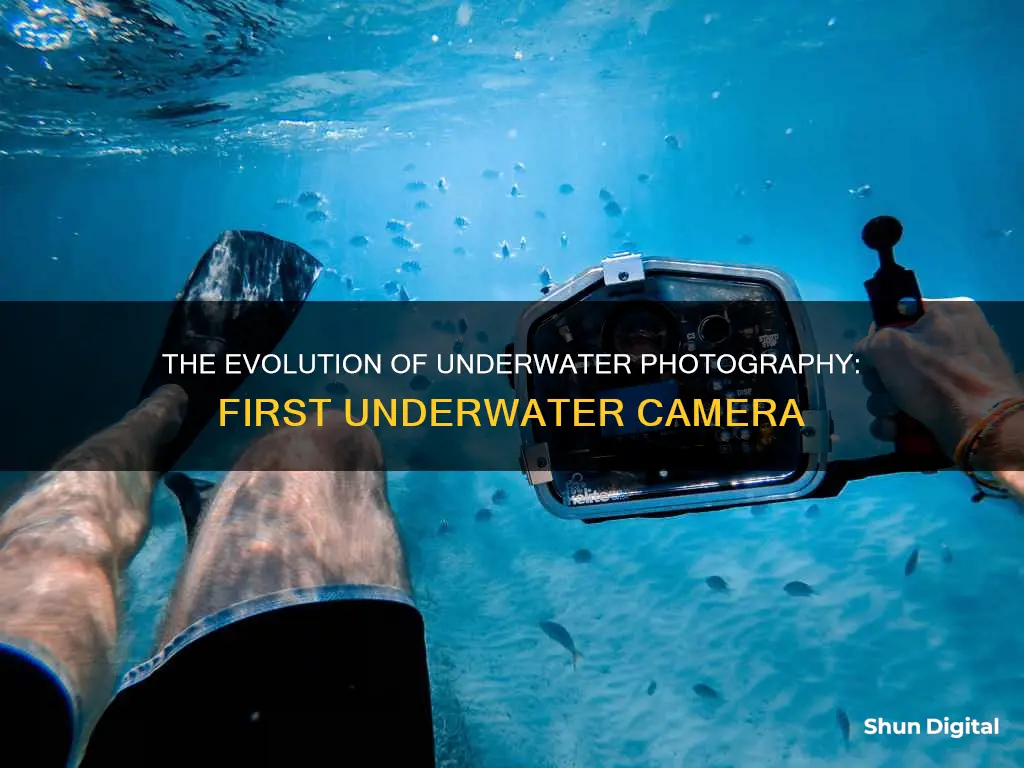
The first underwater camera was invented in 1856 by Englishman William Thompson, who photographed plant life in Dorset, England, by lowering his camera into the water with the help of a pole. The first underwater photograph taken while diving was captured by Louis Boutan in 1893 in Banyuls-sur-Mer, France, using a surface-supplied hard hat. The first commercially available underwater camera, the Calypso, was released in 1963 and later reintroduced as the Nikonos, which became a famous series of underwater cameras.
| Characteristics | Values |
|---|---|
| Date | 1856 |
| Inventor | William Thompson |
| Method | Mounted camera on a pole |
What You'll Learn
- Englishman William Thompson took the first underwater picture in 1856
- Louis Boutan took the first underwater photograph in 1893
- The first underwater colour photos were taken in 1923
- The first commercially available camera housing was produced in 1950
- The first successful underwater commercial still camera was designed in 1957

Englishman William Thompson took the first underwater picture in 1856
Thompson got the idea for the photograph while waiting out a storm in the Portland Ferry Bridge House in Dorset, England. He pondered the possible damage to the underpinnings of the bridge and decided to take a picture to assess the damage. He had a carpenter build a box to encase his camera, with a glass plate on the front and a shutter attached. The apparatus was mounted on a steel pole and lowered from a boat. Thompson operated the shutter by a string from the boat. On his second attempt, he doubled the exposure time and created the first known underwater photo—of boulders and seaweed.
Thompson's photograph was the first half-and-half image (split shot, over-under). It was a technical success, though the image was faint. He later designed a better apparatus but then lost interest in underwater photography. He thought of it only as a useful aid in underwater engineering and never imagined future generations using a similar process to take photographs of marine life in situ.
Charging Spy Button Cameras: A Step-by-Step Guide
You may want to see also

Louis Boutan took the first underwater photograph in 1893
Louis Boutan was a French professor, zoologist, biologist, and photographer. He was also a pioneer in the field of underwater photography. In 1893, he took the first underwater photograph, having developed equipment for underwater photography with his brother, Auguste, an engineer.
Boutan's passion for marine zoology and studying molluscs in their natural environment drove his desire to innovate underwater photography. He experimented with various techniques and technologies, including waterproof casings, heavy glass plate negatives, and magnesium powder for illumination.
Boutan's first attempts at underwater photography involved encasing cameras in strongboxes and barrels, and even trying to flood the interior of cameras. Eventually, he created a watertight apparatus that could withstand pressure, although it was so large that it required three men to lift it.
To address the issue of lighting, Boutan collaborated with French electrical engineer M. Chaffour in 1893 to create the first flashbulb. This experimental model involved igniting a magnesium ribbon inside a glass bottle filled with oxygen, producing an intense flash of light.
Boutan's persistence and passion for science and marine life allowed him to make history, giving humanity its first glimpse of the underwater world.
Understanding Panoramic Photography: Pano Mode in Cameras
You may want to see also

The first underwater colour photos were taken in 1923
The history of underwater photography is a fascinating one, with the first-ever underwater photographs taken in 1856. However, these were black-and-white images, and it would be almost 70 years before the first underwater colour photos were captured.
In 1923, the first underwater colour photographs were taken by botanist W.H. Longley (also referred to as Dr William Longley) and photographer Charles Martin, a staff photographer for National Geographic. They photographed stationary objects like corals, anemones, and sea fans in the Florida Keys, using a magnesium-powered flash to illuminate their subjects. Longley's photos were later published in the July 1927 issue of National Geographic magazine.
The pair used a specially designed waterproof camera housing, with the flash powder in a raft on the surface of the water. When they pressed the camera shutter, it tripped a battery on the raft, triggering an explosion that illuminated the underwater scene up to 15 feet deep. The scene was around 15 metres (49 feet) deep, demonstrating the incredible brightness of the magnesium flash.
This groundbreaking achievement paved the way for future advancements in underwater imaging, with the first generation of 35mm-format cameras specifically designed for underwater photography becoming available for purchase in 1957.
Replacing the Battery in Your Kangaroo Doorbell Camera
You may want to see also

The first commercially available camera housing was produced in 1950
The creation of underwater housings was a significant milestone in the history of underwater photography. These waterproof casings allowed conventional cameras to be used underwater, opening up the field to many more photographers. Underwater housings varied in complexity, from simple bag-like designs to custom-made casings for specific camera models.
The first underwater housings were typically custom-made, very expensive, and used only by professional photographers. They were large and heavy, making them inconvenient and challenging to handle underwater. Additionally, they were not always reliable, and many cameras were lost to leaks and malfunctions.
With advancements in materials and design technology, modern underwater housings are more reliable, compact, and affordable. They are typically made from polycarbonate or aluminum, which are durable and resistant to seawater corrosion. Today's housings are designed for specific camera models, ensuring photographers have access to necessary controls while keeping their equipment safe from the harsh underwater environment.
Understanding SCN Mode on Your Camera: What You Need to Know
You may want to see also

The first successful underwater commercial still camera was designed in 1957
The creation of the Calypso camera was a significant milestone in the history of underwater photography. It was one of the first cameras designed specifically for underwater use, with a built-in close-up lens and a usable underwater viewfinder. Its unique design and affordability captured the imagination of both professional photographers and hobbyists, leading to a surge in popularity for underwater imaging.
The Calypso camera was also notable for its compact size and ease of use. Unlike earlier underwater cameras, which tended to be bulky and cumbersome, the Calypso offered a more streamlined and user-friendly option. This made it ideal for divers and underwater enthusiasts who wanted to capture their experiences in a marine environment.
The impact of the Calypso camera extended beyond its technical specifications. By making underwater photography more accessible and exciting, it paved the way for more profound exploration of the underwater world. Photographers were now able to capture and share stunning images of colourful coral reefs, diverse marine life, and other vibrant underwater scenes. This, in turn, stimulated public interest in ocean exploration and marine conservation.
The success of the Calypso camera also led to further innovations in underwater imaging technology. The Nikonos, its successor, introduced interchangeable lenses and greater pressure resistance, enabling photographers to capture images from even greater depths. The development of underwater housings, or waterproof casings, also played a crucial role in expanding the possibilities of underwater photography by allowing conventional cameras to be used underwater.
Understanding Raw Camera Format for Photography
You may want to see also
Frequently asked questions
The first underwater photograph was taken in 1856 by Englishman William Thompson. He lowered the camera into the water in Weymouth Bay, England, using a pole for support.
No, William Thompson did not scuba dive. He simply lowered the camera into the water.
The first underwater camera was invented by French marine biologist Louis Boutan in 1893. It was a big, bulky, and complicated wooden box camera.
The first commercially available underwater camera was the Calypso, released in 1963. It was later renamed the Nikonos.







